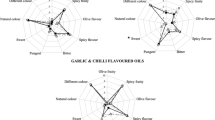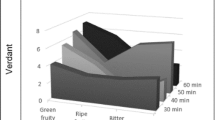Abstract
In this study eight olive oil samples produced in different processing systems were analyzed and compared. It was shown that extended processing systems tend to result in lower quality oil. Slight differences were observed among the virgin classes of the samples. The antique process sample had higher phenolics content, bitterness, throat catching, and lower values of positive sensory terms. It was shown that the second decantation oil was lower in almost all quality criteria and truly is a lampante, non-food use sample. Quantitative descriptive analysis (QDA) of the samples has indicated that positively defined terms were higher in the virgin class of the samples than the refined class of the samples. But consumer hedonic measurements did not differentiate the samples. Buying intentions of the refined samples were as high as the values for the virgin samples. Models of consumer buying intentions included appearance and flavor as significant factors. Multidimensional scale analyses of data have shown that olive oils can be grouped successfully by common quality and sensory parameters.


Similar content being viewed by others
References
Boskou D (1996) Olive oil, chemistry and technology. Chap 1, 3, 7, pp 1–11, 52–84, 101–121, AOCS Pres, Champaign
Ranalli A, Malfatti A, Lucera L, Contneto S, Sotiriou E (2005) Effects of processing techniques on the natural colorings and the other functional constituents in virgin olive oil. Food Res Int 38:873–878
Vinci G, Chiacchierini E, Mele G, Restuccia D (2007) Impact evaluation of innovative and sustainable extraction technologies on olive oil quality. Trends Food Sci Technol 18:299–305
Fregapane G, Gomez-Alonso S, Mancebo-Campos V, Salvador MD (2007) Evolution of major and minor components and oxidation indices of virgin olive oil during 21 months storage at room temperature. Food Chem 100:36–42
Codex standard for olive oils and olive pomace oils (2003). Codex Stan 33–1981 (Rev. 2–2003)
Caporale G, Policastro S, Carlucci A, Monteleone E (2006) Consumer expectations for sensory properties in virgin olive oils. Food Qual Pref 17:116–125
Yılmaz E, Öğütçü M, Mendeş M (2008) Sensorial and physico-chemical characterization of virgin olive oils produced in Çanakkale. J Am Oil Chem Soc 85:441–456
Free fatty acids (1998) In: Official methods and recommended practices of the American Oil Chemists Society. Official method, Ca 5a–40
Peroxide value, acetic acid-chloroform method (1998) In: Official methods and recommended practices of the American Oil Chemists Society. Official method, Cd 8–53
Rice-Evans C, Re R, Pellegrini N, Proteggente A, Pannala A, Yang M (1999) Antioxidant activity applying an improved ABTS radical cation decolorization assay. Free Radic Biol Med 26:1231–1237
Animal and vegetable fats and oils. Determination of individual and total sterols contents—Gas chromatographic method (TSE EN ISO 12228) (2003). Turkish Standards Institute (TSE), Ankara
Yılmaz E, Öğütçü M (2009) Comparison of the virgin olive oils produced in different regions of Turkey. J Sensory Studies 24:332–353
Yılmaz E, Öğütçü M (2009) Path Analysis for the behavior of traditional olive oil consumer in Çanakkale. Food Sci Technol Res 15(1):19–26
Minitab (2000) Minitab statistical software, release 13.20, USA
SPSS (1994) SPSS professional statistics 10.1. SPSS Inc., Chicago
Carlo MD, Sacchetti G, Mattia CD, Compagnone D, Mastrocola D, Liberatore L, Cichelli A (2004) Contribution of the phenolic fraction to the antioxidant activity and oxidative stability of olive oil. J Agric Food Chem 52:4072–4079
Gorinstein S, Belloso OM, Katrich E, Lojek A, Ciz M, Miguel GN, Haruenkit R, Park YS, Jung ST, Trakhtenberg S (2003) Comparison of the Contents of the Main Biochemical Compounds and the Antioxidant Activity of Some Spanish Olive Oils as Determined Four Different Radical Scavenging Tests. J Nutr Biochem 14:154–159
Kayahan M, Tekin A (2006) Zeytinyağı Üretim Teknolojisi (Olive oil production technology). GMO Pub, Ankara
Rial DJ, Falque E (2003) Characteristics of olive fruits and extra-virgin olive oils obtained from trees growing in appellation of controlled origin ‘Sierra Magina’. J Sci Food Agric 83:912–919
Lyon DH, Watson MP (1994) Sensory profiling: a method for describing the sensory characteristics of virgin olive oil. Grasas y Aceites 45:20–25
Organoleptic Assessment of Olive Oil (1992) International Olive Oil Council, COI/T20/Doc no. 3/Rev. 2, Madrid (Spain) 28.5.1992
Pagliarini E, Rastelli C (1994) Sensory and instrumental assessment of olive oil appearance. Grasas y Aceites 45:62–64
Acknowledgments
This article was produced from the M.Sc. thesis of Birsen Pehlivan, completed in 2009 in the Graduate School of Science and Engineering of Çanakkale Onsekiz Mart University. We also thank regions olive oil processors who generously donated the oil samples.
Author information
Authors and Affiliations
Corresponding author
About this article
Cite this article
Pehlivan, B., Yılmaz, E. Comparison of Oils Originating from Olive Fruit by Different Production Systems. J Am Oil Chem Soc 87, 865–875 (2010). https://doi.org/10.1007/s11746-010-1569-y
Received:
Revised:
Accepted:
Published:
Issue Date:
DOI: https://doi.org/10.1007/s11746-010-1569-y




